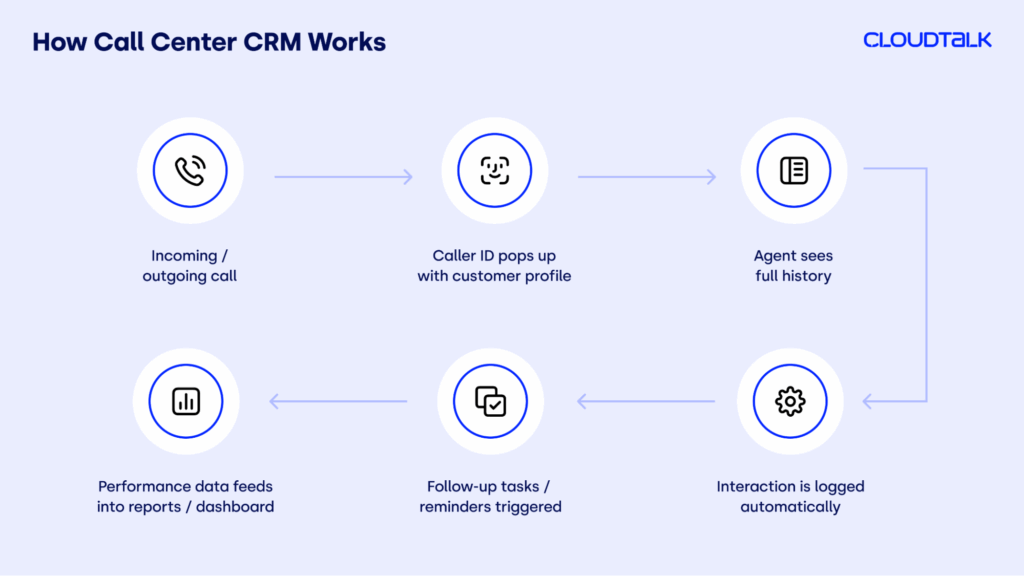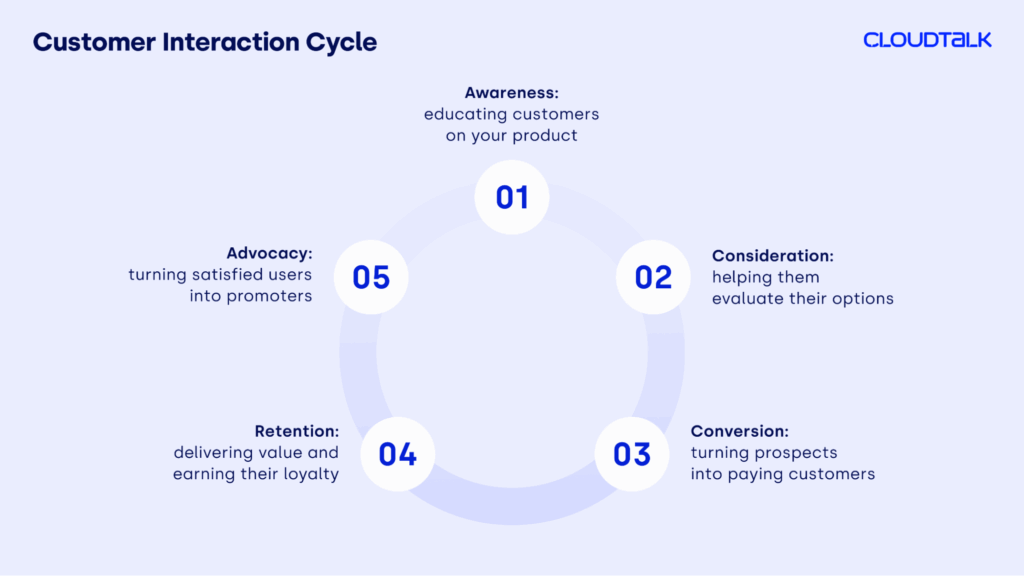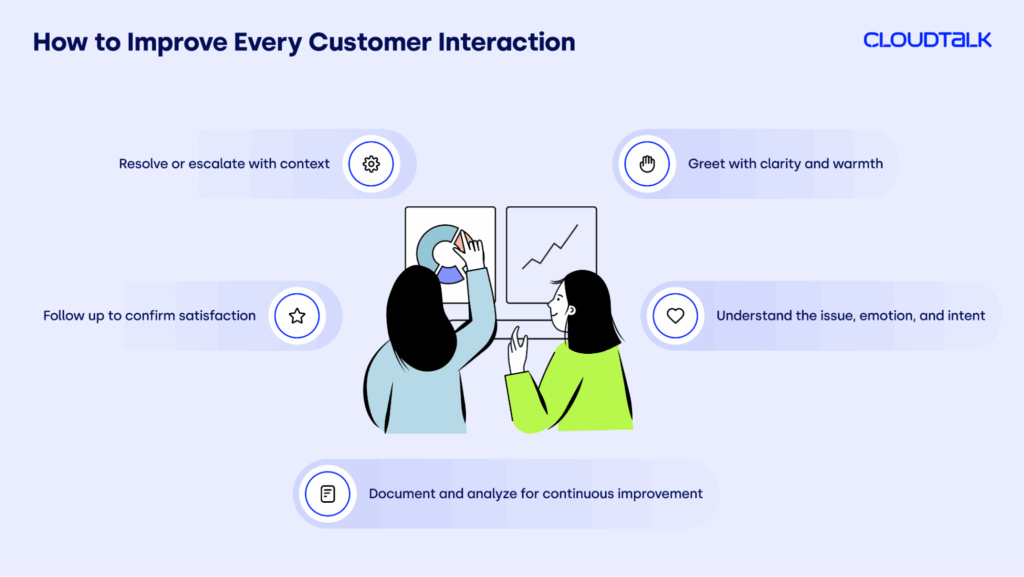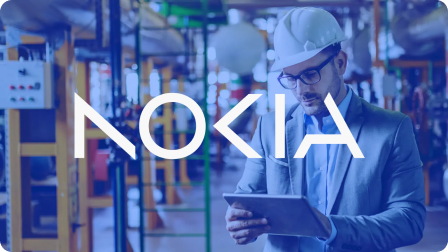12 Customer Interaction Improvements for SMBs in 2025

Would you keep buying from a business that ignores your messages or makes you repeat yourself?
While the answer is an obvious “no”, the reality is quite shocking—bad service and poor CX cost companies $3.7 trillion each year.1
In this guide, we’ll show you how to improve customer interactions across support, sales, and success.
You’ll also get real-world customer interaction examples, practical tips on how to interact with customers, and 12 strategies that’ll improve your interaction with customers, including smart ways to use AI without losing the human touch.
Key Takeaways:
- Customer interaction improvement starts with emotion. When you understand how customers feel, it’s easier to build trust.
- To manage customer interactions well, follow the patterns. Smart Notes and Trending Topics show what’s working and what’s not.
- Every interaction with customers is a chance to win loyalty. Even small moments can make a big difference.
- Best practices for customer interactions start with being real. Listen, stay human, and let AI help you scale that.
Stop losing customers due to poor experience. Start building trust today.
What Are Customer Interactions?
Customer interactions are any exchanges between your business and your customers, whether that’s a phone call, an email, a chatbot message, or an in-person visit.
These moments might feel small, but they’re where you build (or break) loyalty.
Each interaction with customers gives you a chance to:
- Understand customer needs more clearly.
- Demonstrate your brand voice through action.
- Solve problems before they escalate.
- Drive retention, upsells, and positive word-of-mouth.
- Provide a chance to learn and offer even better customer service.
And they’re happening constantly across marketing, sales, support, and even billing. That’s why improving these interactions isn’t just a CX team task. It’s a company-wide commitment.
12 Tips to Improve Your Customer Interactions in 2025
Ready to level up? Here are 12 proven tips (including a super smart one!) to improve customer interactions that work and scale.
1. Understand Your Customers as People
Start by ditching assumptions and digging into the real motivations, frustrations, and preferences of your customers. Use feedback, surveys, Call Recordings, and CRM data to build a complete customer profile.
Want to improve customer interaction and engagement? Show customers you truly “get” them and tailor your service accordingly.
2. Show Empathy and Gratitude
When a customer is angry, don’t just solve the problem. Validate their frustration, thank them for bringing it up, and reassure them they’re not just a ticket number. A sincere “thank you for your patience” goes a long way.
Empathy turns a support conversation into a relationship. It’s a key ingredient in every positive customer interaction.
PRO TIP
Did you know that even the angriest customers can be turned into loyal ones—if you handle the moment right? Watch this short video for proven techniques to de-escalate, show empathy, and improve customer experience in high-pressure moments..
3. Be Reliable and Follow Up
Say what you’ll do, then do it. Reliability builds trust, which in turn improves every customer service interaction.
Use follow-ups (email, SMS, callback) to check if the issue is resolved and the customer is satisfied. Tools like Smart Dialer (automated sequential outbound dialing ) and Callback (automatic missed inbound call redial ) help teams stay consistent even with high ticket volumes. And they allow you to treat customers professionally at scale.
4. Communicate Openly and Honestly
Transparency builds credibility. If you don’t have the answer, say so, and commit to finding out. If there’s a delay, let them know before they have to ask.
Or use tools that help you do that in real time, like Call Monitoring or Three-Way Calling, which let supervisors join or observe live calls without disruption. These features make it easier to loop in a colleague when you’re unsure—so you can stay honest without losing momentum or confidence.
That kind of openness doesn’t make you look unprepared—it builds trust. And it shows exactly what is successful customer interaction in action.
Just don’t forget there are some Dos and Don’ts that apply to 3-Way Calling.

5. Collect and Apply Customer Feedback
Ask for feedback, but more importantly, act on it. Whether it’s a post-call CSAT score or a public review, these insights highlight what’s working (and what’s not).
Need a starting point? Check out our guide on sentiment analysis for AI-powered ways to track emotional cues in conversations.
6. Delight Customers with Small Gestures
A well-timed thank-you. A discount after a service hiccup. A small gift to mark a milestone. These gestures don’t just feel nice, they make your customers remember.
In B2B, where interactions often feel transactional, thoughtful moments like these humanize your brand and build lasting trust.
Pair them with smart timing and the right context, and you’ll turn everyday interactions into loyalty wins.
Get 50% OFF your 1st month & start improving customer interactions today.
7. Let Customers Use the Tools They Love
Make it easy for customers to connect on the tools they already use. In B2B, your buyers and users are already juggling platforms, and forcing them to switch tools just to talk to support? That’s friction they’ll remember…one that might even make them churn.
If voice is your primary channel, that’s fine—but don’t let it live in a silo. Use CRM integrations with platforms like Zendesk, Intercom, or HubSpot to sync conversations, surface customer context, and keep everyone aligned.
Even without an omnichannel platform, you can still deliver a seamless experience, because the real value isn’t in which tools you use. It’s in how well they work together.
Want to see how that kind of integration works in real time? The visual below breaks down exactly how a connected call center CRM can streamline customer interactions, step by step.

8. Speak Like a Human, Not a Corporation
Sales scripts are super useful, but they shouldn’t sound like a robot wrote them. Use natural language, simple explanations, and a friendly tone. The goal is to make your customers feel heard, not handled.
That kind of communication doesn’t just happen. You have to learn it. And that goes for every role, from support reps to sales agents. If you want consistent, human conversations at scale, start by training your agents in empathy, voice, and clarity as soon as you hire them.
9. Use Tone and Delivery to Build Connection
Words matter. But how you say them on a call (your tone, pace, and energy) matters even more. These signals build trust, show empathy, and make remote interactions feel personal.
Even small shifts in tone can change how customers feel about your brand, so make sure your team knows how to use their voice as a relationship-building tool.
10. Offer Multi-Channel Support
Customers don’t care which channel they use—they just want answers. Let them move from chat to phone or email without repeating themselves.
To make that work, combine a multi-channel call center solution with a customer-first approach. Together, they keep conversations flowing by syncing context across tools and reducing frustration by letting customers pick up right where they left off, no matter the channel.
11. Train Your Customer Service Team Continuously
The best reps aren’t just friendly, they’re always improving. To build customer loyalty and better experiences, you need to invest in regular coaching sessions, call reviews, and skill-building programs that go beyond product knowledge.
But knowing what to coach and when isn’t always obvious. That’s where AI steps in. It identifies skill gaps and surfaces training opportunities you might otherwise miss.
12. Smarten Up Interactions While Staying Human
And once you’re tracking the right signals, every conversation becomes a source of insight.
Here’s how:
Tools like Sentiment Analysis help you understand how customers really feel during a conversation. By picking up on tone and emotion, your teams get all the context they need to respond with more empathy, spot issues early, and build better relationships.
Then, AI Smart Notes and AI Trending Topics take it a step further, capturing what was said and surfacing the themes that come up again and again. What happens if you employ all these features in your daily interactions? You get a clear view of patterns across calls, so you can double down on what’s working and quickly fix what’s not.
Why it matters:
These insights show you where to adjust your language, timing, or escalation tactics, letting you fix problems before they escalate and fine-tune how your team connects.
Done right, sentiment data doesn’t just explain past calls. It sharpens every future customer interaction, making your service more empathetic, timely, and human.

pro tip
You don’t have to improve every interaction on your own. With AI insights and connected workflows, modern call center platforms like CloudTalk quietly handle the complexity, so your team can stay focused on building stronger customer relationships.
Why Are Customer Interactions Important?
Customer interactions are real turning points.
Every message, call, or follow-up tells your customer something about how seriously you take their time, their goals, and their experience. And the impact isn’t just personal, it’s also strategic.
Here are five reasons why improving customer interactions drives long-term business value:
- They create momentum
A well-handled interaction today makes the next one easier. Each positive moment builds context, reduces friction, and increases customer confidence in your team. - They reveal the truth before the data does
Customer conversations surface issues long before they show up in Dashboards. The right interaction tools can help you spot common pain points and operational gaps early, while there’s still time to act. - They affect revenue outcomes directly
Customer churn often begins with a single bad interaction. On the flip side, proactive, empathetic communication drives upsells, renewals, and referrals. Customer experience is now a revenue engine, not just a support metric. - They power coaching and performance improvement
Real interactions with customers give managers real coaching material. With tools like Call Recordings, Summaries & Tags, and sentiment scores, teams can stop guessing and start giving targeted, practical feedback that actually helps reps improve. - They fuel product and CX innovation
When your team tracks patterns in conversations, such as repeated questions, customer tone, or the timing of issues, they gain insights that go beyond support. These insights can help improve onboarding, fix confusing parts of the product, and make marketing messages clearer.
When companies treat every conversation as a chance to improve, the results are hard to ignore.
Take Glovo. By streamlining agent workflows and cutting average call handling time by 50%, they made customer interactions faster, more consistent, and easier to scale across teams and regions. The tools that made it possible? CloudTalk.
Cut call handling time in half, and double up on customer satisfaction.
Practical Examples of Customer Interactions
Let’s put customer interaction into practice, shall we?
Here are three quick customer service interaction examples that show how stronger interactions can directly impact loyalty, revenue, and retention.
Use Case 1: The Lost Subscription (Support)
Lisa, a busy SaaS (Software as a Service) customer, found herself locked out of her account. Her credit card had expired, auto-renewal failed, and none of the alert emails reached her. Frustrated, she opened the chat and typed one word: “Cancel.”
How the team saved it:
- Chatbot escalation: AI bot immediately routed her to the best available agent.
- Empathetic call: The rep acknowledged the frustration and reactivated her access, without repetitive verification.
- Follow-up: Lisa got a brief email with a 10% loyalty credit and a billing update link.
This worked because everything (chat, call, CRM) was connected through the integrated Dashboard. It wasn’t just fast, it removed friction from every step of the interaction.
Use Case 2: The Repeat Buyer (Sales)
Alex had bought from this leather goods brand before. This time, he called with a question about premium boots.
The sales agent didn’t jump into a generic pitch. With full access to Alex’s purchase history through CRM integration, they paused, listened, and suggested a matching belt based on his previous order. Alex bought both.
What made the difference:
- Smart silence: The agent didn’t rush. With Talk/Listen Ratio, they could see in real time how much space they were giving the customer to speak.
- Personalization without pressure: CRM context revealed Alex’s past purchases, making the upsell feel natural.
- Coaching at scale: AI-generated Call Transcription, Summaries, and Topics Extracion helped sales managers identify and reinforce these moments across the team.
This is what positive customer interaction looks like: understanding, not upselling.
Use Case 3: The Referral Opportunity (Success)
Maria had just finished a scheduled follow-up call with a customer success agent. As they were wrapping up, she casually mentioned that someone from another team was asking about the call center software they were using.
How the rep responded:
- Spotted the signal: Instead of moving on, the agent thanked her and acknowledged the interest as a referral opportunity.
- Followed up fast: Sent a referral link and a short message right after the call to make it easy for Maria to share.
- Logged it smartly: Tagged her in the CRM as a potential promoter, so the team could track and engage later.
Moments like this often go unnoticed, unless you’re using tools like automatic Call Tagging and Sentiment Analysis to surface them.
The Customer Interaction Cycle in Action
If your support or sales process feels inconsistent, it’s often because customer interactions aren’t mapped to the whole journey, or they’re missing a consistent structure altogether.
At the big-picture level, the customer interaction cycle follows five key stages:
- Awareness: educating customers on your product
- Consideration: helping them evaluate their options
- Conversion: turning prospects into paying customers
- Retention: delivering value and earning their loyalty
- Advocacy: turning satisfied users into promoters

But zoom in, and you’ll see that every stage, whether it’s a sales call or a post-purchase check-in, is made up of smaller interactions that either build trust or chip away at it.
Here’s a simple five-step structure teams can use to improve each customer interaction:
- Greet with clarity and warmth
- Understand the issue, emotion, and intent
- Resolve or escalate with context
- Follow up to confirm satisfaction
- Document and analyze for continuous improvement

Check out this story to see what happens when the customer interaction cycle is done right.
Turn a Broken Onboarding into a 5-Star Review
Emma had just signed up for a free trial, but her onboarding call was cancelled, and two follow-ups went unanswered. By the time she called support, she was frustrated and ready to quit.
The rep didn’t skip over the emotion. She greeted Emma warmly, used her name, and referenced past case notes. Then she asked: “Why is the timing important?”
Emma explained she had a product launch in five days.
That changed everything.
The rep escalated the request, scheduled a same-day onboarding session with a senior specialist, and sent a personalized setup guide. She also extended the trial by 14 days. The next day, Emma got a quick check-in call and a CSAT survey.
Behind the scenes, the entire conversation had been tagged, summarized, and logged in CloudTalk, so the next rep would pick up right where the first left off.
Emma didn’t just stay. She became a promoter and even left a 5-star review on G2, mentioning the rep who’d handled the situation to her satisfaction.
PRO TIP
What saved Emma wasn’t just empathy, but rather context. Tools like Call Transcription, AI Smart Notes, and Sentiment Analysis gave the agent instant insight into Emma’s experience. With that context, she responded faster, escalated smarter, and turned frustration into a 5-star review.
You Don’t Need More Customer Interactions—You Need Better Ones
Remember the $3.7 trillion?
You don’t want to add to the total money lost yearly by businesses that don’t try to improve interactions with their customers.
No worries, avoiding that outcome is very simple. A well-timed follow-up and smart call handling is often enough to turn a frustrated, almost churned customer, into a 5-star review.
This isn’t just about speed or scale. It’s about getting every conversation right. Because better interactions protect revenue, prevent agent burnout, and turn everyday service into real connection.
CloudTalk gives businesses exactly what they need for customer interaction improvement: Features like Sentiment Analysis, AI Smart Notes, or Callback help teams respond faster, personalize better, reduce churn, and significantly improve customer experience.
Our experts will show you how to win customers…and keep them!
Sources:
FAQs:
What is the customer interactions meaning?
Customer interactions are any exchanges between a business and its customers across calls, messages, emails, or meetings.
What are the different types of customer interaction?
Customer interactions include phone, email, chat, SMS, social, in-app, and face-to-face touchpoints—each requiring consistent interaction management across channels.
What are the methods for tracking customer interactions?
Teams use CRM logs, call recordings, and AI-powered analytics to monitor and optimize every customer-facing moment.
What metrics are used to measure customer interactions?
Standard customer interaction metrics include CSAT, NPS, resolution rate, and talk-to-listen ratios, which you can track through call center voice analytics.
What are the 5 key customer interaction skills?
Key customer interaction skills are: empathy, active listening, clarity, follow-through, and adaptability. You can improve them through interactive service training.
What AI tools are brands using to automate their customer service interactions in 2025?
Solutions like CloudTalk’s AI communication tools help automate customer service through AI-powered routing, tagging, summarizing, and sentiment detection.
How can you use technology to improve customer interactions?
Use technology like omnichannel engagement platforms and automated feedback tools to scale personalization and CX alongside your business.
What is the primary objective of customer interaction analytics?
The goal is to surface behavioral patterns that improve CX and retention—often powered by real-time customer sentiment analysis.
What are the best practices for customer interactions?
Some of the best practices when interacting with customers you should follow are: listen actively, speak clearly, and follow up fast.

























